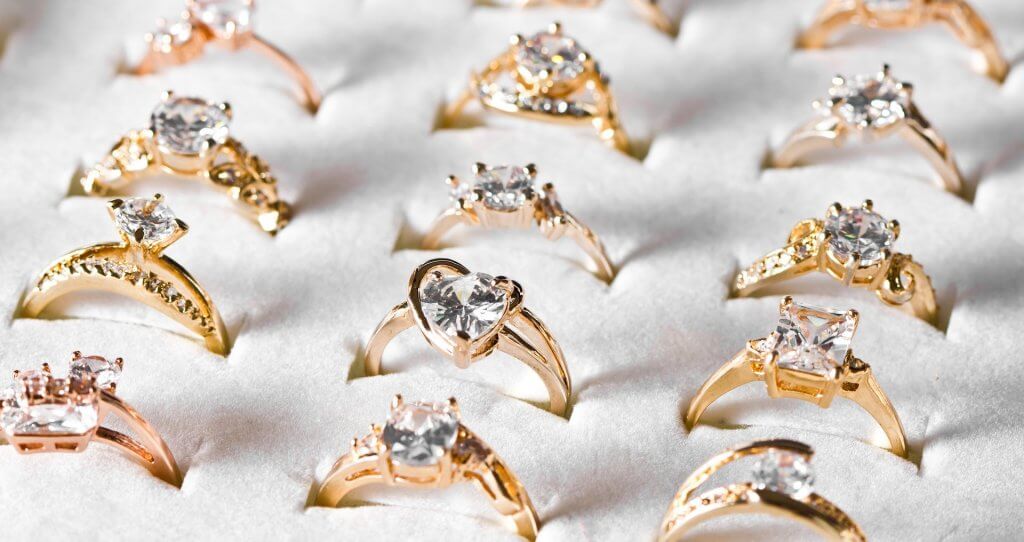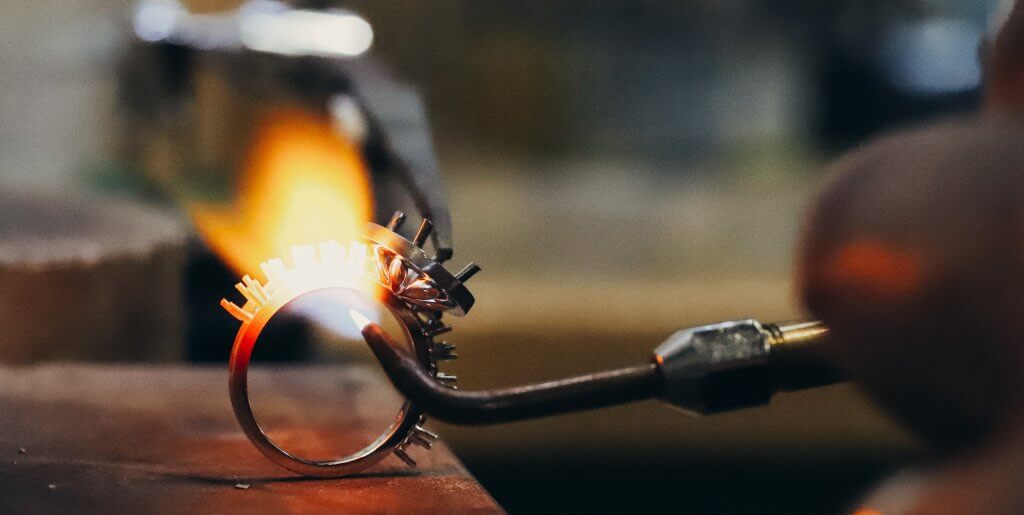Protect your love today with engagement ring insurance!
Key Takeaways
- Engagement ring insurance is a little like a safety rail, there to stop you from succumbing to a worst-case-scenario should the issue rear its ugly head.
- There are a lot of things that can go wrong when you’re wearing a high value ring every day, from theft to damage (no matter how well the ring has been made).
- Engagement ring insurance doesn’t typically represent a major financial burden – and, at the same time, it protects you from the financial burden of replacing something worth thousands of dollars.
- You might want to add it into an existing policy, or create a new one for the ring alone. Either way, don’t just assume it’ll be covered under your homeowner’s/renter’s insurance.

First comes love, then comes a diamond, then comes browsing the internet for insurance because, oh dear, you’ve just realized quite how much money is sitting on the fourth finger of your fiancées hand while she shops, rides the subway, travels abroad, rifles through her overcrowded handbag, walks along the beach, through the woods, along the pier – or, really, anywhere where a diamond could vanish forever.
Sure, Kim K got teased by millions of internet users for crying over her lost diamond earrings (now somewhere at the bottom of the Tahitian Ocean), but the average engagement ring is a very different story. We can’t imagine the feeling of looking down to find your diamond has worked itself loose, or that the entire ring has just upped and disappeared – but looking down to find your finger empty and not having some kind of financial safeguard in place?
Unthinkable.
Here is our comprehensive guide to everything you need to know, understand, and do when it comes to insuring your engagement ring. Purchasing a policy may not be anywhere near as exciting as purchasing the ring itself, but it’ll sting a lot less.
First of all, what could go wrong?
Diamonds are incredibly sturdy, durable stones. After all, a large part of the reason why they’re the top choice for engagement rings (beauty and sparkle aside) is down to their strength. On the Mohs scale of hardness, which compares the hardness of different natural substances, diamond is the highest ranking – much higher than many other beautiful gemstones like sapphire and morganite.
Provided they’re made by an expert, the rings themselves are also incredibly durable. Though many are designed to look light, ethereal, and delicate enough that a slight knock could push them out of shape, these rings are forged from strong metals – and, most importantly, are designed to last lifetimes. 14K and 18K gold, for instance, is strong enough to be worn for decades – or longer.
Essentially, a good jeweler won’t send you home with a risky ring. Diamonds are valuable items, and most buyers can’t just head back into the jewelers to replace one that’s disappeared every few years (or, even, decades).
Still, things can and do go wrong. If a ring isn’t checked regularly, even a single loose prong could mean the difference between keeping your diamond in the family forever and losing it on some random Thursday afternoon. Pavé stones are a little more likely to fall out, and that’s why some jewelers are reluctant to recommend them for wedding bands – although, thankfully, they are much cheaper to replace.
Ultimately, the biggest risk comes down to losing or misplacing the ring. Plenty of women are in the habit of removing their rings before washing their hands (or washing dishes) in other to avoid getting soap caught in the setting, and plenty of women have walked away from public restrooms before realizing that ring is still on the side.
Finally, the risk of theft is always an issue worth considering. Unfortunately, none of us can guarantee that we won’t be targeted, whether at home or during travel, and preparing for those worst-case-scenarios is always worth your while.
What is Engagement Ring Insurance?
It’s a policy taken out to offer financial protection against the risk of damage to or loss of your engagement ring. These policies will pay out the cash value or replacement cost of the ring, so that you can purchase a replacement without being out of pocket.
These policies generally also cover unpreventable incidents like fire and wind damage, but the exact type of coverage will depend on where you live and how high a premium you’re willing to pay.
In a nutshell, however, engagement ring insurance is a policy you should be seriously considering the second you walk out the jewelry store with your engagement ring.
Aren’t Engagement Rings Covered on Home Insurance?
Maybe, but there’s a better change that your engagement ring is not covered by your existing homeowner’s or renter’s insurance policy – even if the policy you took out mentions jewelry.
Under most homeowner’s and renter’s insurance policies, jewelry is covered up to a certain amount – for instance, your policy may stipulate a single-item limit of $1,500. For many of the more ‘everyday’ pieces of jewelry we keep in our collections, this is sufficient in the event that someone breaks in, or something else goes wrong.
But, for the average engagement ring, this single item limit is way short of the mark. Last year, the average amount of money dropped on an engagement ring within the United States was around the $6,000 mark – so you can imagine how much of a risk shoppers take when they assume that their engagement ring is automatically covered within the ‘jewelry’ category on their homeowner’s or renter’s insurance policy.
Under some circumstances, you might be able to choose to add an extension onto your homeowner’s or renter’s insurance policy for your engagement ring – covering that value that wouldn’t have been covered originally – but you can also take out a dedicated policy, depending on what works best for you.

How Much Will Your Insurer Pay Out?
The exact amount your insurer will be obligated to pay out to you will depend on three things – first of all, the ring itself (since all engagement rings have different values) and, second of all, whether your policy stipulates that it will pay out the actual cash value or the replacement cost of the ring, and whether or not your policy has a deductible.
While it may sound like two ways of saying the same thing, there’s a major difference between being paid the cash value of the ring, or the cost to replace it.
Actual Cash Value
We’ve mentioned before on WillYou.Net that, while diamonds have excellent long-term value – they’re unique, and a finite natural resource after all – their value tends to dip immediately after purchase. Relatively recently purchased engagement rings generally don’t do all that well on the secondhand market, unless they’re from an esteemed luxury retailer like Cartier or Tiffany & Co. or, of course, owned by a person of interest.
What does this mean for your insurance? That being paid the actual cash value of the ring could be a major disappointment.
Let’s say you bought a $10,000 engagement ring. In the jewelry store, its cash value was $10,000 but, immediately after you purchased it, its value naturally dipped. If it gets stolen or lost, your insurer won’t pay you $10,000 – they will pay you the cash value the ring held when it was stolen instead. True, a pay out like that will take some of the sting out of losing the ring, but it won’t make it possible for you to replace it without dipping back into your savings account to make up the difference.
Replacement Cost
By contrast, a policy that pays out the replacement cost of your ring will provide you with the cash needed to get a like-for-like replacement of the ring – minus any deductible the policy requires. This is a much better idea if you can find the right policy, since it means being able to replace your engagement ring with a like-for-like alternative without having to augment the pay-out with a significant portion of your savings.
In other words, you won’t have to feel like you’re practically buying the ring twice over – and, with something as valuable as an engagement ring, that means a lot.
Is Engagement Ring Insurance Expensive?
Compared with the cost of replacing an engagement ring that has been lost, stolen, or damaged? Not at all. That said, all policies are slightly different and finding a good deal on your engagement ring insurance is likely to be a process of shopping around.
In general, the average policy holder will see a yearly cost of around 1-3% of the value of the ring. Your monthly payments are likely to remain relatively low – but, for obvious reasons, it’s always worth sitting down to crunch the numbers.
So, that engagement ring with a ticket price of $10,000 could end up costing you a yearly sum of between $100 – $300. Obviously, that cost could go up based on your risk factor as a policy holder – factors like where you live – and that yearly expense could be compounded by a (potentially) high deductible, but this gives you an initial indication of what you can expect.
Ultimately, however, paying out the price of a couple coffees a month to protect you from a significant loss is worth it. You can’t be sure that nothing will ever happen to that ring and, while the sentimental value can’t be replaced, you can make sure that you will always be able to keep a beautiful ring on your partner’s finger.
Do You Need an Appraisal to Get Engagement Ring Insurance?
Maybe, but not necessarily. Appraisals are advised for rings that have been passed down through the family or purchased second-hand, but a recently purchased (and brand new) ring probably doesn’t need an appraisal.
For new rings, you can prove their value by showing your prospective insurer a copy of the receipt from your jeweler. Remember that every diamond’s value is determined based on a unique set of characteristics, and that’s another reason why shopping from a reputable jeweler who sells GIA certified diamonds is key.
We’ve written about diamond ring appraisals in the past, and the fact that they’re not always as useful for people like you as they sound like they’re going to be. Appraisals can result in an overestimation of value – something that lies in the insurer’s interest, since it means they can charge a premium for coverage.
For that reason, if you do need an appraisal, a reputable, local jeweler will be the best person to turn to. They will give a very honest, accurate appraisal of the ring’s true value, without swaying it in the insurer’s favor. Don’t send it off to a remote appraisal company in the mail – the risk is just not worth it.
Also, remember that, even if you have the original diamond report for your ring – say, a GIA report with all the diamond’s characteristics listed within it – you do not have a document indicating the value of the diamond or ring unless you have it appraised. Diamond reports are not proof of value.
Engagement Ring Insurance: The Pros and Cons
As with any policy or added expense, there are benefits and disadvantages to taking out engagement ring insurance.
The Pros
- The worst-case-scenarios are mitigated
While we tend to focus on the exciting parts of investing into an engagement ring (for obvious reasons), it’s always worth stating that making any investment of this size into a single item is daunting. Shoppers will spend significant portions of their savings on these rings, and knowing how easily lost or stolen can be the kind of thing that keeps you up at night.
An insurance policy is your umbrella. It can’t reduce the risk of that worst-case-scenario coming true, but it can stop that scenario from impacting you with anywhere near the same force.
- You will be able to find a replacement (hopefully of a similar value)
Diamonds are unique objects, so you will never replace your ring with a diamond that is identical to the one you have now, but there are plenty of diamonds priced at the same value that will prove just as beautiful, and just as special within a new, replacement ring.
Being able to afford to replace that ring as soon as possible will prove invaluable to you if the time ever comes. Besides the monetary value, it’s impossible to overstate the feeling of being able to continue wearing that symbol of your commitment and promise to one another – especially when it has been taken away from you temporarily.
- Most people only pay 1-3% of the ring’s value per year
Nobody likes to take on yet another expense but, as far as monthly/yearly expenses go, the average insurance policy on an engagement ring is relatively low. Month by month, the average policy holder only needs to set aside the cost of one or two cups of coffee to ensure that, if the worst happens to their ring, they don’t have to be left with nothing.
- It’s usually a very simple process
If you’re adding your engagement ring insurance onto your existing homeowner’s or renter’s insurance policy, then it’s probably a relatively simply process of calling up your insurer and proving the ring’s value to them.
Otherwise, taking out a new insurance policy tends to be almost as simple. It’s something that, these days, you can do online – and for a lot less time than it took you to choose the ring in the first place.
The Cons
- It’s another cost to consider
While it may not be a huge expense, some of us have to think very carefully about adding any extra onto our monthly expenditure. This is particularly true if you’ve just dropped 95% of your savings on a diamond ring.
But, even if you don’t take out your insurance policy right away, it’s worth keeping it as a high priority in your head. Given its value, it’s worth trying to reshuffle your finances to accommodate the monthly payments, because replacing an entire ring is a much more devastating blow to your bank account.
- There may be scenarios that aren’t covered by your insurance policy
Always read the fine print, particularly when you’re dealing with insurance companies. It may not be that they’re trying to get one over on you, but, even if you’re used to checking off the terms and conditions without a single glance in their direction, don’t take any chances on this one.
Sometimes, insurance companies will avoid providing coverage for certain situations. These may not apply to you (for instance, you may not travel internationally), but, then again, they may do. Read it carefully.
- You can’t be compensated for sentimental value
Of course, the elephant in the room – the fact that no amount of money could ever replace the sentimental value held by that original ring. While a replacement ring could look just as beautiful, it won’t be the same ring that was there the day you got down on one knee and popped the question.
The thing is, with an insurance policy, you can at least protect the rings value as much as possible. You can make new memories with the replacement ring, without having to derail your savings for a second time.

Mar 26, 2022 By Willyou.net
Understanding the Differences: Anniversary Band vs Wedding Band

Mar 17, 2022 By Willyou.net
Shine a light on Diamond Scams: Protect yourself








